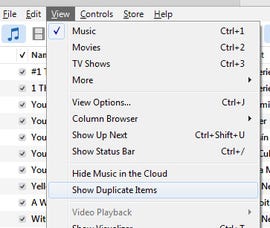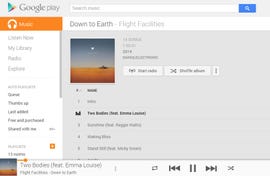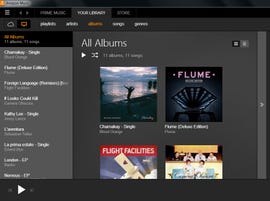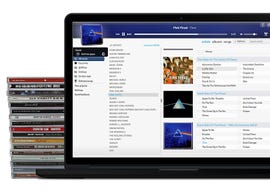Easy Way to Move Cds to Cloud

As an avid music fan, I spend ages getting my personal music collection just right, picking and choosing from CDs, vinyl and digital files to make a library that's uniquely my own.
But once all that hard work is done, it's nice to be able to stream any of those tracks across devices -- even when I'm away from my main computer.
Here's a guide on how to organize your music and choose a cloud streaming service to listen to tunes wherever you are.
Clean it up
Before transferring any of your music to another service, it's important to make sure that everything is nice and neat before pushing it to the cloud. Save yourself the hassle of having to fix everything once it's elsewhere by doing it offline.
This means making sure all your digital files are tagged properly. There are several tools that will do this all for you, or you can take a manual approach if you have more obscure songs in the mix.
Tagging: For Windows, try Magic MP3 Tagger which helps clean up ID3 tags and match songs against data in the MusicBrainz database. If your collection has other file formats like FLAC or OGG, try Picard.
For Mac, Metadatics works with a number of different file formats and includes features like batch editing, album artwork and the ability to search for metadata via Amazon and Music Brainz.
De-dupe: Run a check for any duplicate files to remove them from your collection. Do this using a tool like Duplicate Cleaner (Windows only) to weed out any double-ups in your library.

If you run iTunes, there is a way to remove duplicates. For iTunes 12, follow these steps:
- Open iTunes and select My Music, just underneath the playback bar
- On the right hand side of the iTunes window, from the drop-down menu choose Songs
- This should brings up a list of all your tracks. Click on the Name column
- Click View and then Show Duplicate Items. On Windows, press Alt to bring up the File/Edit/View menu.
- Delete files individually. You may want to turn on a column view for bitrate so you keep the highest quality version of any duplicates.
Artwork and folders: To make sure that your file structure and folders are all in good shape, you can run Bliss which runs on Windows and Mac. It also fixes any album art issues and consolidates genres. For $46/£30/AU$57, if you are looking for a solution to fix all your music in one go, it's a decent investment.
Also for iTunes users, check out Matt Elliott's great guide on cleaning up your library.
Once your existing digital collection is all looking good, it's time to get it into the cloud. Here are some of the services available, and what they offer.
Google Play Music

For the greatest flexibility in making your existing music collection accessible via the cloud, Google's music locker is the one to beat. Upload 20,000 of your own songs for free to Google's servers, and then have those songs available to stream on web or mobile (iOS and Android).
To get started you will need to set up an account and download the Music Manager application for Mac or PC. This will keep an eye on folders you've flagged, or watch iTunes/Windows Media Player. Then, it will upload music you've added and match anything from your own collection against Google's own collection to save from having to upload unnecessarily.
Tracks are copied at 320kbps and support is available for most major file types (MP3, FLAC, OGG, AAC, WMA and ALAC).
On top of your own collection, you can sign up for All Access, which is Google's streaming music service. So if you have gaps in your library, you can fill them with All Access, provided the albums or songs you want are available on the service.
Platforms: Web, iOS and Android.
Price: Free to upload 20,000 of your own songs, then $10/£10/AU$12 per month if you want to add an All Access subscription.
Best for: The ultimate flexibility across devices, and a slick web interface.
Amazon Music/Prime Music

Amazon's cloud offering is somewhat similar to what Google offers in that it is a music locker and a streaming service, but it is more limited than the search giant's version. Using Amazon's service, you can upload up to 250 songs for free. With a subscription of $25 per year this opens up to 250,000 songs.
Amazon Music Importer will grab files from iTunes, Windows Media Player or selected folders and upload to the cloud. Like Google Play Music, it only uploads songs that it doesn't find a match for in the Amazon collection. Music is imported at 256kbps and it recognises most major file formats (MP3, M4A, WMA, WAV, OGG, FLAC, AIFF).
Amazon Prime members can access Prime Music, which is a streaming service that has a catalogue of over a million tracks. It offers a smaller collection than other competing offerings.
Platforms: The Amazon Music player runs on Mac, PC, a web interface, Android, iOS, Fire Phone and a number of other platforms.
Price: Free for the first 250 songs, then a $25/year subscription opens up storage space for 250,000 songs.
Best for: Users with huge music libraries.
iTunes Match

While there is no free option, Apple's iTunes Match is a robust way to integrate all your digital music and have it available across devices. It's ideal for those who are heavy iTunes users and have music that is sourced from all sorts of different places.
As suggested by the name, iTunes Match automatically matches songs in your library against the 43 million songs in the iTunes Store. Then, if it can't find a match for a particular track, iTunes will upload it to iCloud. Users can play back their collection from up to 10 separate devices. The service lets you store up to 25,000 tracks of your own, or more if some songs are purchased through the iTunes Store.
The main issue is that if you have a collection of music that spans a variety of file types that aren't supported (e.g. FLAC, OGG and so on) you need to convert those to AAC, MP3 or WAV before they can be uploaded.
Platforms: PC or Mac for iTunes, and iOS devices for iCloud playback.
Price: iTunes Match is $25/£22/AU$35 per year.
Best for: iTunes and iOS users.
Style Jukebox

For those who want to stay away from the big providers, Style Jukebox is a music locker that uploads songs from your own collection to the cloud. It keeps an eye on folders and as soon as something is added, it uploads automatically.
The Style Jukebox interface is clean and easy to use. Upload up to 20,000 songs with a premium subscription otherwise a free account gives you storage space for 250 songs. Once uploaded, your tracks can be streamed from Windows PCs, Android, iOS and Windows Phone devices.
Free accounts support major file formats (MP3, WMA, AAC and OGG) while the premium subscription opens up FLAC and M4A compatibiulity.
Platforms: Windows PCs, Android, iOS and Windows Phone.
Price: Free for the first 250 songs, then a premium account ($3 per month or $25 per year) opens up more space.
Best for: Smaller music collections who want total independence from the "big three" (Google, Apple and Amazon).
Your own cloud
For extensive music collections, or those who would rather make their own solution, consider setting up a media streamer -- a DIY cloud of sorts.
Subsonic lets you stream music (and other media) from your home computer. By installing the Subsonic server on the computer where your digital music library lives, you have access to all those files through remote access. As long as your router has a public IP address, Subsonic lets you set up a username to point to a custom URL like http://cnetmusic.subsonic.org.
There are also apps available for Android, iOS, Windows Phone and Chrome if you would rather listen to music on the go.
Plex is a media server that can be run across Windows, Mac or Linux devices and then lets you stream to a whole range of mobiles, tablets or TVs. Plex offers monthly, yearly or lifetime subscriptions and offers extensive features for all sorts of media, not just music.
Source: https://www.cnet.com/tech/home-entertainment/how-to-keep-your-music-library-organized-with-the-cloud/
0 Response to "Easy Way to Move Cds to Cloud"
Post a Comment